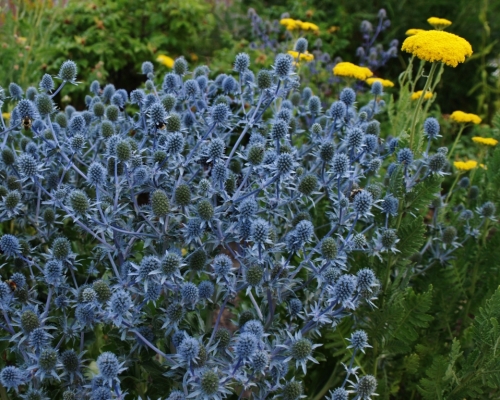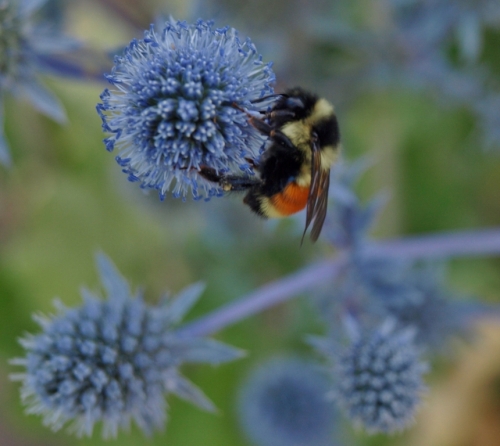
Eryngium planum ‘Blue Cap” – thriving in less than ideal conditions at the 108 Roadhouse Heritage Site, Lac La Hache. We planted the raised perennial beds at the rest stop there over 10 years ago with “tough, no-maintainence” plants, and it is quite interesting to see what has survived and, in most cases, thrived. This sea holly and Achillea filipendulina, Salvia nemerosa, Lychnis coronaria and Silene maritima, a goodly number of columbines, Erigeron ‘Pink Jewel’ and various sedums are hanging right in there. Exposed site, no supplementary water or fertilizer, and lots of traffic back and forth – we’re pretty happy with how this planting has held up. Photo taken in the late evening while stopping by for a quick break to stretch our road-trip weary legs, mid-August, 2012. Image: HFN
Perennial. Zone 2. Apiaceae. Central Europe, from Germany and Austria eastward to Russia; throughout the Caucasus Mountain region and into central Asia, where it grows happily in grassy meadows and on rocky, sun-baked hillsides.
I’ve been a die-hard fan of the sea hollies in general and this species in particular ever since my mother planted one out on her difficult-ground shale hillside north of Williams Lake over four decades ago. It self seeded about, and made a thriving colony, and provided untold hundreds of sturdy bloom stems which ended up being dried and made into everlasting wreaths and arrangements which Mom then gave to friends and sold at various arts-and-crafts sales.
It really is as blue as it looks, and the stems carry that cobalt blush as well, almost as if the whole thing were dusted with spray paint by someone seeking to enhance things.
Leathery, silvery-green, rounded leaves in basal rosettes send up 18-24” tall multi-branched stems topped by loose clusters of bristly, bracted, cone-shaped flower heads summer through fall. Stems and flowers are flushed a deep electric blue. A very long season of bloom through summer into autumn.
An excellent cutflower and everlasting. A popular bee and butterfly flower, always alive with insect activity.
‘Blue Cap’ – translated from ‘Blaukappe’ – is a premium German selection of the species, and is even more compact and floriferous (and darker blue) than its attractive ancestor. A number of other E. planum cultivars have appeared in recent years, such as the very dwarf ‘Blue Hobbit’, and white forms such as ‘Silver Salentino’ and ‘White Glitter’.
A variegated form, ‘Jade Frost’, with pink-blushed, white-edged foliage, has been appearing in garden centres for a few years; I have a small planting of this cultivar and am at this point not terribly impressed, as one of the original trio mysteriously withered and died, and the other two are less vigorous than I had hoped for from this generally reliable species.
Sun; any soil; drought tolerant. Fantastic xeriscape plant. A generous self-seeder, but not a “runner” – individual plants stay put, and are tap rooted and very long lived. Oh – and it is reasonably deer resistant, too!

